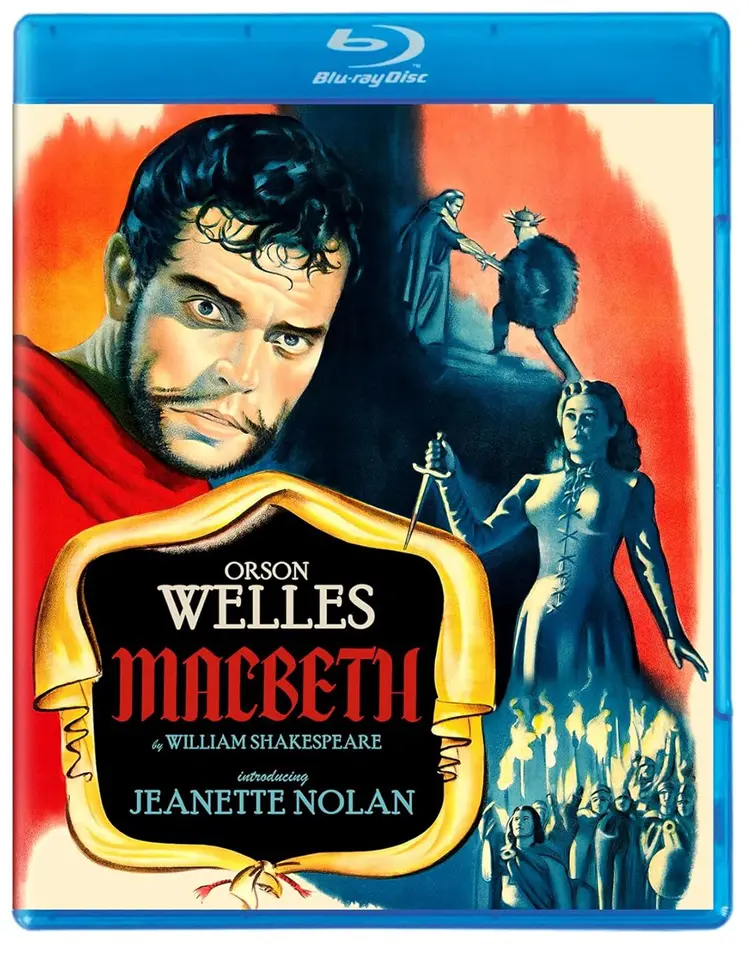
William Shakespeare was one of the greatest writers in the English language. Macbeth is arguably his greatest play. Orson Welles was a wunderkind whose very first film, Citizen Kane, is often cited as the greatest movie ever made. Welles directing and starring in an adaptation of Macbeth ought to have been an instant classic. But it wasn’t. Even today it is considered to be one of Welles’ lesser films. Some of this has to do with the constraints placed upon Welles. As was often the case with Welles’ directorial efforts, the studio gave him a small budget, and an even smaller time frame, and demanded cuts be made to his final print.
Buy Macbeth (Special Edition) Blu-rayWelles had the final cut on Citizen Kane, but after that, the studios always seemed to interfere. It was after this film that he left for Europe, struggling to find financing for his films in America and finding a more sympathetic audience overseas. Macbeth was financed by Republic Pictures, a small American studio looking for prestige. Still, they only gave him $800,000 to make his movie.
To save money, he used sets and costumes leftover from Republic’s B-movie westerns. He shot the film in 28 days. There are times when you can see those limitations on the screen, but Welles is too good an artist to allow those moments to be much of a distraction. The film isn’t quite a classic, nor is it my favorite adaptation of Macbeth, but it is better than its reputation.
Welles and cinematographer John L. Russell shoot it like a strange mix between a stage production and a film noir. The sets look, well, like sets in a play. The castle, where most of the film takes place, is less a castle and more of a series of hollow caves dug into a rocky mountain with rooms and a throne carved out of them. The trees are twisted and gnarled. The backdrop is what looks to be a plain white cloth draped at the back of the set. At no point does anything look real, but it works in its own strange and beautiful way. Characters are often shot in close-ups, from sharp angles (something Welles often did in his movies) which gives the film an off-kilter feel, but also keeps you from focusing on the seams from his recycled sets and costumes. The shadows are deep, and the light is often harsh. That gives the film a noir feel.
Welles was a terrific actor, but he tended to overshadow everyone else. That is certainly the case here. Macbeth is an oversized character but Lady Macbeth (here played by newcomer Jeanette Nolan) is arguably more important. It is her prodding that sets much of the action into place. Yet at almost every turn, Welles pushes his character into the forefront. Even during Lady Macbeth’s famous “Out Damned Spot” speech, Welles inserts Macbeth into the scene, watching from the sidelines (in the play he is completely absent). Oddly enough, during what is arguably the play’s most affecting soliloquy, “Tomorrow and Tomorrow…,” Welles pointed his camera at a series of clouds instead of himself.
To save money, Welles had the actors pre-record their dialogue, European style. Initially, he had them speak in their best Scottish accents (Macbeth is the “Scottish Play” after all) but after dismal previews, the studio made them redub it in their normal voices (and then got Welles to shave about 20 minutes off the runtime). This changed version was the only available version for many years. It wasn’t until 1980 that audiences got to see the original version. This Kino Lorber set presents both versions of the film.
To be perfectly honest, I did find myself drifting a bit during parts of this film. Part of that comes from being over-familiar with the source material. I’ve read the play, seen it on stage a couple of times, and I’ve seen multiple cinematic adaptations. I won’t say the story has lost its power, but this adaptation certainly failed to hold my attention at all times. Of course, part of that was also due to me watching it at the end of a long, hot day.
There are some striking images throughout the film including a scene where Malcolm (Roddy McDowall) stands before a legion of soldiers holding long staffs with crosses on the ends of them that look strangely like crosshairs. During the final battle, the trees of Birnam wood are cut down and used as camouflage by the soldiers as they attack Macbeth’s castle. Welles finds them in deep fog and it looks like something out of a hallucinatory nightmare.
Macbeth is my favorite of Shakespeare’s plays. I’ve seen at least four cinematic adaptations of it. This version may be my least favorite of them all and yet there is still much to admire. It is well worth watching and this set from Kino Lorber is a great way to do that.
Kino Lorber presents Macbeth with a nice-looking 4K scan. Extras include a new commentary from Tim Lucas, an archival commentary from Joseph McBride, a 2016 interview with Michael Anderegg, a 2016 interview with Peter Bogdanovich, an interview with Robert Gritt about the film’s restoration, and an interview with Marc Wanamaker about Republic Pictures.